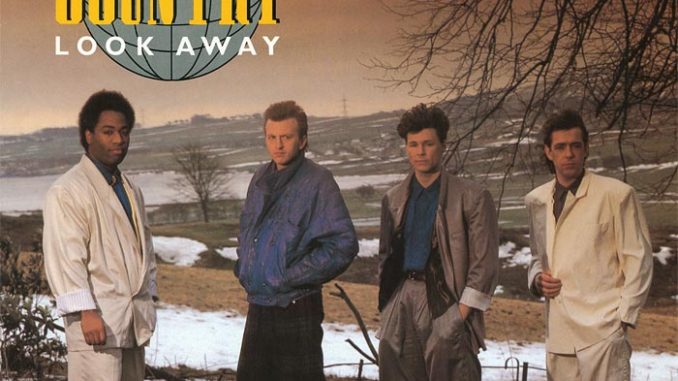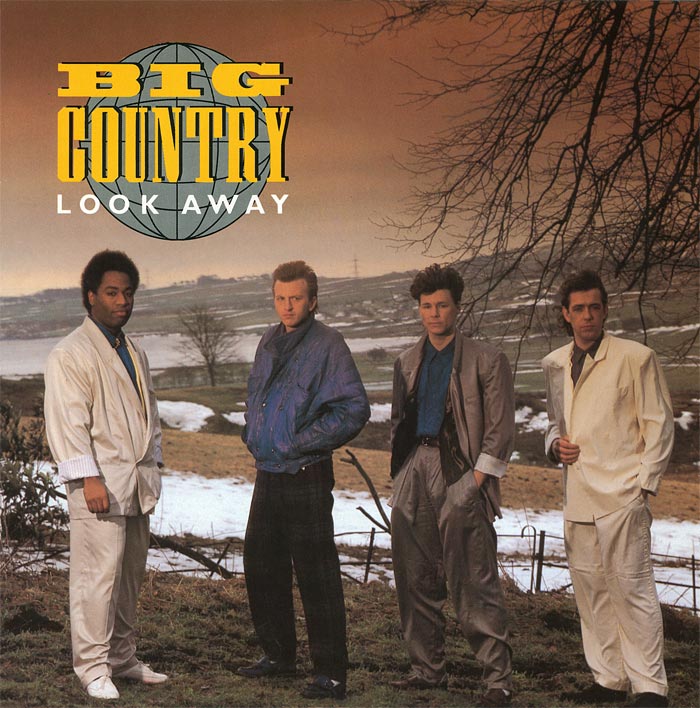
Look Away is the first track on Big Country’s third album The Seer, released on 30 June 1986. It was the first single from the album, released nearly three months earlier on 4 April 1986. It remains the band’s biggest hit in most markets where they have a recorded chart placement (including UK, Ireland, Netherlands, Switzerland, Finland, and New Zealand). It is a high performer in just about all others, including barely being beaten by In A Big Country as their most ever popular song in the ‘Mainstream Rock’ radio chart in the US.
The band had been on a hiatus of sorts when they reconvened to record their third album The Seer by autumn of 1985. There had been no tours that year, but Stuart Adamson (vocals/guitar) had seen the birth of his daughter Kirsten. The others had worked on various projects – including Roger Daltrey’s sixth solo album Under A Raging Moon (released August 1985), where Bruce Watson (guitar), Tony Butler (bass) and Mark Brzezicki (drums) all made appearances.
Big Country reconvened again by August/September 1985. Armed with new song ideas, they ended up spending six weeks on further writing, putting together material, and rehearsing it.
Bruce Watson: “There had been a few ideas kicking around all year which we’d saved up – guitar riffs and things which we’d stuck on cassettes or a Portastudio, individually. So we had a few good ideas and took them into the rehearsal studio to work on them. We’d just sort of use the various parts we’d written until we were ready to go into the studio and record.”
There was never a set formula for how the band wrote. “The songs are written in different ways,” Watson elaborated. “Sometimes the four of us can be in soundcheck, just jamming, and one of us will come up with a riff, and we start jamming around that. Sometimes either Stuart, myself or Tony will have a guitar riff or a bass riff, and we’ll start playing it and the other three members will start jamming along. Sometimes Stuart might have the whole arrangement to a song written on cassette which he’ll bring along to the studio and we’ll add our own little bit on to it. Sometimes it’s been known that Mark will go in a recording studio and put down a drum part and the rest of us will do something on top of it. So it works in different ways, and a lot of stuff happens accidentally.”
Look Away was one of the songs that Stuart would bring in in rough form. The original working title of the song was The Outlaw, and a solo acoustic demo of the song was initially done by Stuart on cassette tape.
Musically, the song seems lighter and ‘poppier’ than a lot of the band’s material up to that point. Lyrically, Stuart would often introduce it as a ‘cops and robbers’ story, with the meaning of the lyrics delving into some American ‘Wild West’ history. The background was of course more specific than that.
Bruce Watson: “The idea for the song was taken off a video Stuart watched called ‘Harry Tracy’. It starred Bruce Dern and was about the last of the Wild Bunch, who were outlaws in America.”
Stuart Adamson had certainly been taken with Tracy’s story. “Harry Tracy had a great sense of his own destiny,” he said at the time. “He knew he was out of his time.”
One of Tracy’s claims to infamy is the size and scope of the manhunt for him, and the extensive media coverage of it. This is touched on in the first part of the song, which is about being on the run from the law.
This time we run, this time we hide
This time we draw on all the fire we have inside
…and:
Our name is out, our name is known
Our name is everywhere but who knows where we’ve flown
In real life, Harry Tracey killed at least 11 men and was seen as quite the hardened criminal in his time, from running with Butch Cassidy and the ‘Hole in the Wall Gang’ to robbery and theft. The following blurb could be read in the Seattle Daily Times in July 1902: “In all the criminal lore of the country there is no record equal to that of Harry Tracy for cold-blooded nerve, desperation and thirst for crime. Jesse James, compared with Tracy, is a Sunday school teacher.”
His life was filled with near-captures and last-minute escapes until that fateful day when he found himself cornered in a field by the authorities. He chose to end his own life rather than facing capture.
Look Away certainly is a more light-hearted take on the story than that, and Adamson’s “cop and robber”-introductions definitely seem more befitting of a song which plays more into the romantic view of the dashing highwayman than that of a cold-hearted killer on the run.
Many of the lyrics in the song refer to specific incidents in Tracy’s life. Some of the song’s lyrics go “I never meant to kill a man.” This refers to the time Harry was playing cards with a man when a fight over cheating broke out, and the other man’s gun discharged with a self-inflicting the shot that killed him. Harry was blamed for this murder. We can see him protesting his innocence over this incident in the silent film Tracy The Outlaw (1928).
The chorus goes “Look away, Look away From the lies in the stories that were told,” which alludes to the fabricated stories that were written in the press at the time that were untrue, such as him raping and and killing his school house teacher as a child.
The chorus continues with “Look away, look away From the love that I hide way down deep in my soul.” He was married to the sister of fellow outlaw David Merrill. He escaped from prison to track her down – as the song says:
Then I broke loose, you weren’t around
So I raised banks and trains until I tracked you down
Tracy knew he was an outlaw, and that he was never going to be allowed to live happily ever after with his love. Their ending would almost certainly be a sad one, as is alluded to in the final verse line: “I always knew that we would never find the sun”.
With the song finished and duly rehearsed, it was time to record it. “We booked ourselves into RAK Studios to do the bass and drums,” says Bruce Watson, “because Mark, our drummer, particularly likes the drum room at RAK Studios. We did the guitars and vocals at a place called The Power Plant in Willesden which is owned by Robin Millar, who produced the album.”
Look Away itself was relatively quick to put down. “It was pretty straightforward recording it really,” says Watson, “with no sort of weird tricks or gadgetry on it.”
One of Millar’s favourite memories from recording that album is directly related to Look Away – more specifically the recording of the lead guitar parts. “We needed a new texture and I’d persuaded Stuart to use a Les Paul so we could have a thicker, creamier sound coming in. We set up so that his Marshall amps were miked up out in the studio, but his guitar was plugged in so he could be beside us in the control room. When we pushed up the volume in Studio 1, he could hear this big, rich Les Paul sound and I could tell he was excited. As I sat at the recording console, he stood right behind me playing that wonderful melody. I’m a guitarist and I recognised, just from the vibrato in his fingers, how much he was getting off from doing it. So we rolled the track and, as always, he was brilliant. Then, in the middle of the take, while he was playing, he leant over and into my ear, in his broad Fife accent, whispered: “I’m fucking great!” It was so funny. Only Stuart. And, amazingly, that was the take we kept, that’s what you hear on the record.”
It is always interesting to hear more about how a band record together. Some bands record live in the studio and add needed overdubs, others work things out separately. “When we’re in the studio,” Watson explained in 1986, “there’s usually a couple of us there all the time because we never actually play live in the studio. So it’s not as if everybody has to stay and get bored with hanging around all the time. What we actually do is, we usually lay down a quick track which Stuart and Mark will usually work out for timing. Then either myself or Stuart or both of us will put down a guide guitar, or two guide guitars. Then Tony will put down a guide bass and Mark will play along to this on his headphones. So it’s not as if we’re asked to play live. Then Tony will usually put down his real bass, which only takes him a couple of hours. Tone’s really quick! The next couple of days are usually spent doing the guitars. Then, when Stuart’s got the lyrics ready we’ll come back and deliver some good backing tracks.”
It took the band up to February to finish the album recordings, after which the album was mixed at Maison Rouge Studios. The album mix is unfortunately a point of some controversy amongst Big Country fans. Album producer Robin Millar did an initial mix which was warm and organic, perfectly suiting the material. Dave Bates, head of A&R at Phonogram, for some reason decided that these mixes were no good and would be detrimental to chart success. He promptly ordered a new mix to be done, hiring Walter Turbitt to do it. Unfortunately this mix added reverb, effects and production techniques that may have been popular at the time, but sound somewhat dated now.
This latest move was not popular with the band. Bassist Tony Butler later said, “In the studio, the songs had sounded magic. Robin’s mixes were very powerful. But when we heard the finished album, Walter’s mixes were much weaker. It wasn’t the record we’d made.” Robin Millar was not amused at having his work scrapped either, saying “The intention, nine months before the release of U2’s ‘The Joshua Tree,’ was to move into the area of simple realism, letting the drama and emotion of the song, the lyric and the performance – and the musicianship – replace the drama of digital 80s reverb.” Bruce Watson would add, “Robin’s mix was really organic. In fact, it was probably one of my favourite mixes of all the albums we’ve done.”
The need for the lead single Look Away to be released before the album was fully mixed, meant they needed to use Millar’s mix for that song. This means that the single version of that song the only “Millar mix” released to the public. A side-by-side comparison of that and the Turbitt-mixed album version shows only too well the difference in approach.
But great songs are still great songs, and the fans were quick to embrace the album. It must have been some vindication for Millar that his single mix of Look Away would become the band’s biggest hit overall. It was a very suitable song to release at that point in the 1980s. Bassist Tony Butler concurs: “I can only describe this track as meaningful pop. The melodies, guitar licks and chorus are pure pop. The lyric is intelligent yet accessible.”
Look Away has gone on to become one of Big Country’s most popular songs with the general public, and still goes down incredibly well live. It isn’t always easy to try to create something that is more accessible and catchy without sacrificing the band’s overall sound, but this time, Big Country did.


Facebook Comments